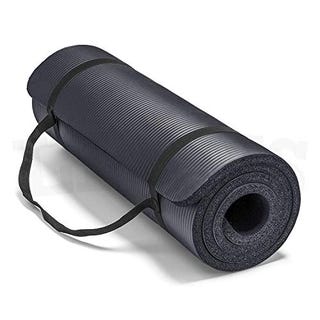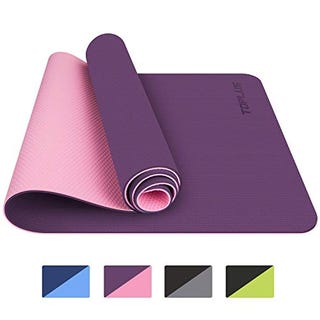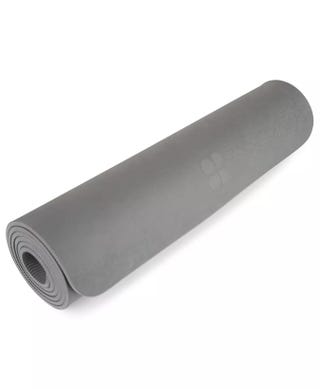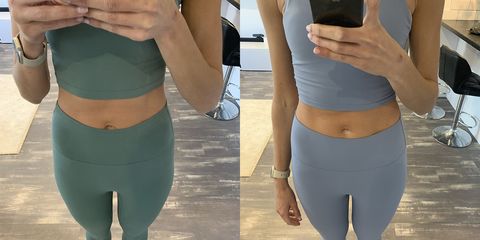The Daisy Keech ab workout has had over 23 million views on YouTube since it went live last year. Keech claims that by doing the ab workout every day, you could carve yourself the perfect ‘hourglass waist’, but I’m sceptical. Exercise alone is highly unlikely to change your body shape – various other factors are at play, like genetics and nutrition (check out our complete guide on how to get a smaller waist) – so to promise a ‘cinched waist’ through a single workout seems deductive. Plus, there’s so much more to be gained from performance goals over aesthetic ones – the sense of accomplishment and confidence that comes with lifting heavier when strength training, for example.
This content is imported from Instagram. You may be able to find the same content in another format, or you may be able to find more information, at their web site.
Granted, the Daisy Keech ab workout may well contribute to more muscle definition, if that’s what you’re after, and if you enjoy the routine, then we’re not saying you should give it up. It’s more that we wouldn’t recommend following a workout routine purely for aesthetic reasons.
What’s more, we’ve been unable to confirm whether or not Keech is a certified personal trainer, which is why we called upon two fitness experts for their verdicts: Anthony Fletcher, a PT and biomechanics expert, and Sarah Winterbottom, Senior Trainer at Barry’s Bootcamp, and a trainer on Courtney Black’s app. Here’s everything they have to say about the Daisy Keech ab workout, after I tried it every day for a week.
What is the Daisy Keech ab workout?
Here’s exactly what’s involved in the Daisy Keech hourglass abs workout. Every exercise is done back to back, no rest for 10 minutes.
- Basic crunches: 1 minute
- Bicycle kicks: 1 minute
- Jack knives: 1 minute, 15 per side
- Russian twists: 1 minute
- Toe taps: 1 minute
- Bicycle crunches: 1 minute, 15 per side
- Scissor kicks: 1 minute
- Reverse crunches: 1 minute
- Butterfly kicks: 1 minute
Is the Daisy Keech ab workout effective?
The chances of it garnering an ‘hourglass’ waist like it claims are slim. Fletcher explains: ‘The shape of your waist is mainly determined by the amount of tissue you have in the area, the shape of your rib cage, your pelvis, and the gap between your pelvis and the ribs. How small or big your waist looks will also depend on how broad your shoulders are.
‘We can’t affect any of these by exercise alone, and doing just 10 minutes a day won’t influence the amount of tissue you have. Most of these factors are down to genetics.’
That said, Fletcher adds that while maintaining a core routine probably won’t do much for said “hourglass” figure, it could be useful in other ways. ‘There is lots of evidence that suggests keeping your muscles around the spine (i.e. your core) active could protect your spine from harm. However, the Daisy Keech hourglass routine is solely focussed on the front of your abdominals and hip flexors, which may create an imbalance in the stability of your spine, if this is the only form of training you do.
‘The upshot is that you may have greater endurance in the anterior muscles of your trunk, neck and hips, but it won’t provide an “hourglass” shape.’
Winterbottom adds: ‘The hourglass workout is focussed on the upper and lower abs. It can be useful to isolate these specific muscle groups, but improving overall core strength should be the goal, and to do this you need to include all three planes of motion (up, down, side to side, and forwards and backwards). The exercises in Daisy Keech’s ab workout cover only the up and down movement.’
My Daisy Keech ab workout review
1.She doesn’t give form cues
Besides an intro and outro, Daisy doesn’t speak during any of the exercises. No form cues, no technique advice. Nada. She does let you know when it’s time to move onto the next exercise, but all she gives is the name of the move. There’s so much to think about when doing ab exercises if you want to do them properly and without injury, and, IMO, it’s the coach’s job to take you through them. Instead, I found myself craning my neck to try and get a closer look at her technique for me to imitate. Not the one.
2. The workout doesn’t incorporate obliques
During her intro, Keech mentions that she doesn’t do oblique exercises because she ‘doesn’t want to build her waist out’, rather ‘cinch it in’. From all the fitness experts I’ve interviewed and research I’ve done in my time, this was a big red flag. I’ve always been told that a balanced body is the one that will serve you best, so to disregard a certain area of your core purely for aesthetic reasons seemed wild.
Granted, a week wasn’t long enough for me to notice any issues, but I’d hedge my bets that if I never did oblique exercises, I’d struggle with other workouts, like yoga and reformer Pilates, which require full body strength.
Fletcher tells me this would almost certainly be the case, adding that neglecting oblique work could increase the risk of injury. ‘Training your obliques is usually done in a lateral direction. If you don’t practice exercises in this plane of motion you could reduce your stability and therefore increase your risk of injury.
‘Your obliques also play a major role in protecting your spine. Every muscle in your trunk, including your obliques, protect your spine by distributing forces through their connective tissue, which reduces stress on the discs of your spine. If you don’t strengthen them, you’ll run the risk of injuring your back.’
Winterbottom wagers that ignoring the oblique area could be particularly problematic in our day and age, when most of us spend a lot of time working from home, which can lead to a ‘more sedentary lifestyle’. ‘Having strong obliques can help reduce lower back pain, which I’m seeing a lot more of nowadays, when a lot of my clients spend more time than ever sitting at a desk,’ she explains, adding that oblique exercises are also key for good posture and balance.
3. Doing the same exercises may be effective, but they can get boring
I don’t know about you, but doing the same exercises day in, day out, quickly got tedious. There’s certainly something to be said for practicing the same moves repeatedly (it’s the only way you’ll get better at them, after all), but there are plenty of other ab exercises that could work the same area.
Fletcher recommends adding in the following moves to your core routine: ‘A simple side plank to increase the capacity of the muscles at either side of your spine would be a good option to add in, as well as a bird dog to train your endurance and neural connections between the lower back muscles, hips and upper back. And a kneeling shoulder tap to train your muscles to resist rotation and keep your spine in a potentially safer position than your usual seated twists.’
And Winterbottom? ‘The most effective core exercises are functional ones that’ll help you move more effectively and efficiently in day-to-day life, and I always make sure my clients’ workouts cover all planes of movement. My favourite core exercises for this are hollow holds, planks, oblique crunches, jackknives and deadlifts.’
4. It may not allow for muscle recovery and growth
Not only does Keech not allow rest between exercise sets, you’re not permitted any days off. This could hinder muscle growth. Several studies have shown that neglecting rest days and overtraining can cause an increase in cortisol (the main stress hormone in the body), which can lead to a reduction of growth hormone (GH) release, which is related to reduced muscle mass and strength.
Fletcher explains how a lack of rest during sets of exercises could also be detrimental. ‘The more burn you feel, the weaker you’re likely to feel, and if this weakness compromises technique then you’ll run the risk of injury, and won’t reap the rewards of the workout.’
He cites one particular study in which one group of rugby players who were pushed to use a weight to failure were compared to another, who did a few reps, followed by a small rest, then repeated another set of reps. The study showed that the group who took rest breaks was just as strong as the group who didn’t. Go figure.
Winterbottom concurs: ‘It’s especially important to maintain form when training your core, as if your muscles fatigue and you let your technique slip, your lower back can start to overcompensate, which is where injury may come in.’
And not taking any rest days? ‘Muscle soreness is produced from muscle damage and the damage must repair before your muscles can function optimally again,’ Fletcher says. ‘If you don’t feel sore the next day, then there was potentially little damage created, and you might be good to go again. But damage and recovery are important factors in getting stronger. I don’t advocate people pushing their muscles hard everyday, as this could potentially disrupt the recovery process and could lead to injury.’
Daisy Keech ab workout: before and after
We’re not about the whole ‘transformation’ rhetoric (they’re often associated with quick fixes, and sustainable, lifestyle habits should always come first), but I wanted to share my ‘before and after’ results, to prove that following the Daisy Keech ab workout every day for a week may not do much at all for your body shape, if that’s what you’re looking for.
I can, however, vouch for the workout working your ab muscles, in that mine definitely ached each day. So, if you take our advice and punt for performance and skill-based goals over aesthetic ones, the Daisy Keech ab workout may well come in useful – just keep in mind our points on form, taking rest if needed and incorporating exercises that target every muscle in your core.
If you, or anyone you know, is struggling with an eating disorder, contact Beat, the UK-based charity who hope to end the pain and suffering caused by eating disorders.
T: 0808 801 0677
E: [email protected], under-18s: [email protected]
This content is created and maintained by a third party, and imported onto this page to help users provide their email addresses. You may be able to find more information about this and similar content at piano.io











More Stories
Home workout guide: How supersets can ramp up your fitness
Bhagyashree’s pre-workout targets quads, glutes and core
How To Organize Your Home, According to ’The Home Edit’